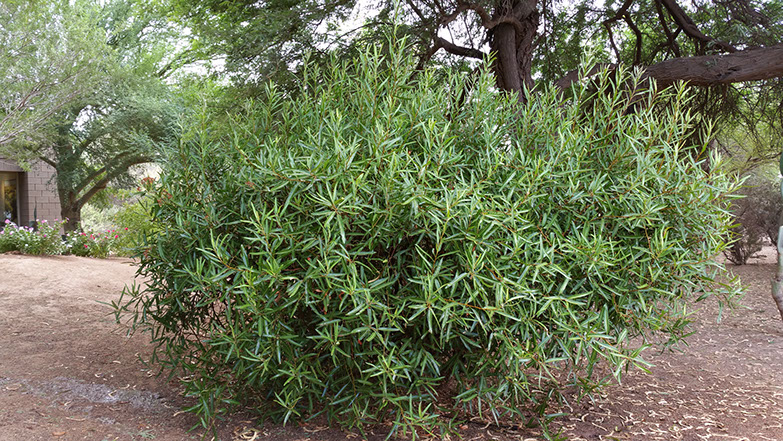


Vauquelinia californica
Arizona Rosewood
Foliage: Evergreen
Mature Height: 8’ - 30’
Mature Width: 5’ - 20’
Growth Rate: Moderate
Hardiness: 10-15 degrees F
Exposure: Full Sun
Leaf Color: Dark Green
Shade: Dense
Flower Color: White
Flower Shape: Dense Flat Cluster
Flower Season: Spring
Thorns: None
Propagation Method: Seed
Sizes Available: #25

Arizona Rosewood (Vauquelinia californica) is a vigorous, dense, upright, evergreen shrub that is an excellent alternative to Nerium Oleanders in all landscape designs. While it is a distant botanical relative of the Rose, its takes it common name from the heart wood of branches that can range from red to shades of brown. It is found in canyons and hillsides in Arizona, Baja and Sonora Mexico at elevations between 2500 to 5000 feet. This large shrub/small tree is reported to be hardy to 10 to 15 degrees. New growth may be a bit less cold tolerant than mature wood. As a desert native it is well adapted to high temperatures and poor soils and grows well in either partial or full sun. It can be naturalized in some desert locations to survive on rainfall or grows well with deep, monthly summer irrigations. Growth rates are slow for young plants. As roots mature and plants become more established growth rates increase. Reports of the mature height and width vary from 8 to 30 feet tall and 5 to 20 feet wide from seed cultivation. Cloning a desirable selection will produce more uniformity. The natural shrub form is the result of numerous low branching, upright stems with dense, alternating, erect leaves. Leaves are dark green, leathery, 2 to 4" long and 1/2 to 1 1/2"wide with serrated or saw-toothed leaf margins. The combination of upright branches and upward pointing leaves give Rosewood its strong columnar growth habit. Flat-topped clusters of snowy white to cream colored flowers (about 3/8" in diameter each) are found from spring to summer. Flowers mature during the summer into dark brown to rust colored hard fruit. Some fruit remains attached through the winter months. It can be used as a tall informal hedge that serves as an effective privacy screen or noise barrier. It requires no pruning but can, over several years, be pruned into a small tree form. It is used as a perimeter planting, hedge, large accent shrub or in many landscape applications were Oleanders are currently used. Its advantages over Oleander include slower growth, ease of maintenance, limited leaf and flower litter, flowers and plant parts are not toxic to people or pets and it can be naturalized in most landscape settings.

© Copyright 2000-2020 Arid Zone Trees